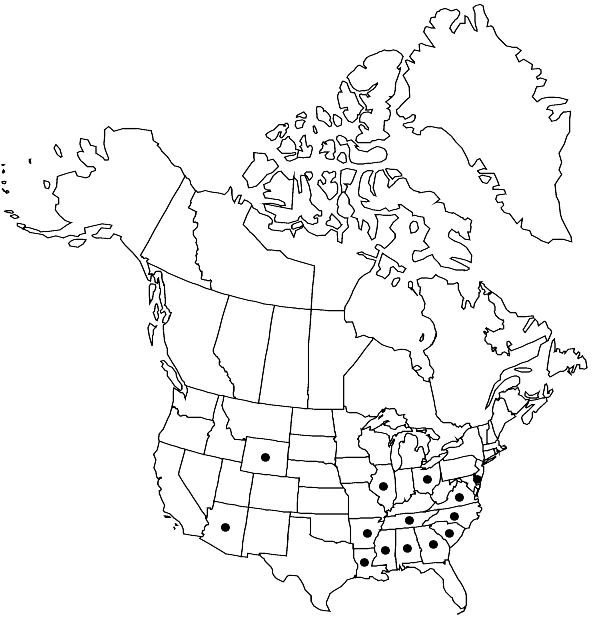Campylopus tallulensis
Musci Bor.-Amer. ed. 2, 17. 1865,.
Plants to 5 cm, in tufts, yellowish green, rarely green. Stems slender, not or densely reddish tomentose, evenly foliate. Leaves about 5 mm, erect-spreading, lanceolate, narrowed to a straight, serrate tip; alar cells hardly differentiated, forming hyaline or reddish auricles; basal laminal cells hyaline, thin-walled, rectangular, often forming a V-shaped area; distal laminal cells short-rectangular, incrassate; costa filling half of the leaf width, shortly excurrent in a concolorous tip, in transverse-section showing large adaxial hyalocysts occupying 1/2 of the thickness of the leaf, and abaxial groups of stereids, abaxially ridged. Specialized asexual reproduction by deciduous leaves or stem tips. Sporophytes not known.
Habitat: Acidic rocks (granite, sandstone), exposed boulders, rarely on soil in open woods
Elevation: 100-600 m
Distribution

Ala., Ariz., Ark., Del., Ga., Ill., La., Miss., N.C., Ohio, S.C., Tenn., Va., Wyo., Mexico, Central America (Nicaragua), South America (Bolivia), South America (Colombia), South America (Peru), South America (Venezuela)
Discussion
The disjunction of Campylopus tallulensis from southeastern North America to Mexico, which is also met in other bryophytes and flowering plants, is considered to be a result of a former continuous range in the Tertiary. Campylopus tallulensis was included in C. flexuosus by American authors. There is a superficial similarity regarding the habit and the shape of the distal laminal cells. Campylopus flexuosus is, however, easily distinguished by thick-walled basal laminal cells and the presence of microphyllous brood branches. Plants of C. tallulensis from Mexico and eastern North America are robust and yellowish to golden green. In contrast, the specimens collected in Illinois, Mississippi (in part), and Arkansas are more slender and dark green, resembling C. subulatus in appearance. It is not known whether these differences in color depend on a different geological substrate or are the expression of different populations. Both species are anatomically very similar with thin-walled hyaline basal laminal cells, almost quadrate distal laminal cells, a costa excurrent in a sometimes subhyaline point and being roughened at the abaxial side like a rat’s tail file and a channeled leaf apex. The only way to distinguish both species seems to be the transverse section of the costa, which shows very distinct groups of abaxial stereids in C. tallulensis but no abaxial stereids in C. subulatus. Furthermore, the adaxial hyalocysts of C. tallulensis are twice as wide as those of C. subulatus (J.-P. Frahm 1994). On the basis of this character, the only records of C. subulatus in North America from California belong to this species and are not extensions of the range of C. tallulensis from Mexico.
Selected References
None.